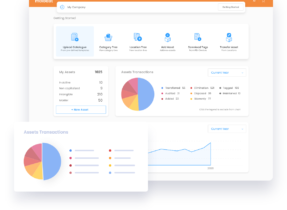Best way to manage your Preventive Maintenance Schedule
Any organization that has Fixed Assets knows the importance of keeping them in tip-top condition. Unplanned breakdowns and faults due to poorly managed maintenance costs businesses $thousands – not to mention the inconvenience and aggravation associated with having to repair or replace broken machinery, tools, or other valuable equipment.
That's why for smooth business maintenance operations a preventive maintenance schedule is of paramount importance – without one, your business cannot run efficiently. So putting a quality system in place is absolutely essential. If you're new to the world of maintenance, this piece will give you all the information you need to know about when it comes to creating predictive maintenance schedules for your equipment and gives you insight into best practices to support your maintenance program. Before we move on, let's quickly recap on what a preventive maintenance schedule is.
What are Preventive Maintenance Schedules?
In brief, a preventive maintenance schedule is a set of tasks that need completion to maintain the condition of your machinery, tools, or other valuable equipment (otherwise referred to as your Fixed Assets). It isn't reactive maintenance, in fact, it's quite the opposite – as its intention is to avoid unexpected breakdowns and keep your operations running smoothly.
A robust preventive maintenance schedule flags up when maintenance is due in advance as well as detects issues before they become problematic. Without a preventive maintenance schedule in place, not only do you slow down your operations, but you risk safety issues for employees as well because unmaintained machinery could result in injury. Your machinery must function to the optimum or your whole factory program could even grind to a halt and when you've got a busy period ahead – that could be disastrous!
Preparing Your Preventive Maintenance Schedule
One of the essential tools you need for an effective, efficient, and reliable preventive maintenance system is a Computerized Maintenance Management System or CMMS software maintenance which is one, complete system that covers off everything required for smooth-running business operations. The most reliable system is without doubt, Mojodat Maintenance and for inventory management, Mojodat Inventory.
A quality system will immediately point out any small issues before they become major problems and put into place a schedule of maintenance for all of your Facilities, Equipment, and Fixed Assets. It will also assign tasks, create maintenance alerts, and formulate work orders so your team understand what is expected of them and when. There is no margin for error, as everything is computerized and automated – unfortunately, with manual preventive maintenance schedules, there is far too much human error attached which means that these types of systems are notoriously unreliable. Here's more on how to build a preventive maintenance schedule and what a computerized system can do for you.
1. Input the Data
To begin with, you will have to input all of your Fixed Assets but once it's done, it's done – of course, as you add to your inventory, new or replacement items will need to be uploaded. The types of Fixed Assets that definitely need monitoring are those that are critical to your business success (e.g., if you're in manufacturing, your machinery), those items that could fail without maintenance in place (for example, your HVAC system), expensive and valuable machinery or equipment, and those that deteriorate over time (this applies to most machinery and equipment – especially if it is constantly in use).
2. Building a History
A CMMS keeps all data for each Fixed Asset together. So over time it builds a history of maintenance dates, reduces maintenance downtime due to breakdown for each asset, warranties, cost price, any replacement parts etc. This enables your team to plan in preventive maintenance easily. With a CMMS system, as all history is stored and collected as time goes on automatically you gain instant access to all relevant data for each Fixed Asset.
Other ways to store data are through Excel but it's much harder to manage as these spreadsheets are not designed for large amounts of data and they're difficult to use on-the-go as you can't update them properly without a desktop or laptop, leaving margin for error or critical information not being uploaded. A CMMS system is designed especially for this type of task, plus it works on-the-go through maintenance mobile apps – making your maintenance team's life much easier!
Of course, every Fixed Asset is different and therefore has different requirements in terms of maintenance and expected life. That's why the above information is important. Additionally, it's essential that you keep each asset's manual. Understanding each asset's requirements will help you to assess when maintenance will need to be performed initially, when you start using a CMMS System. Once you've noted this, the system will act accordingly and flag future dates, flag up alerts and produce work orders, rather than leaving it to a team of people constantly checking up on critical dates.
3. The First Schedule is Produced
When all the initial information is uploaded – to start your CMMS Maintenance Management System off (the system will manage everything on your behalf going forwards), your first preventive maintenance software schedule will be produced and will detail all tasks needed for each asset, and how often they need to be done.
4. Making Adjustments
Using a quality CMMS System, you can make adjustments as you see fit – for example, you might find that certain pieces of equipment doesn't need as much preventive work as others, this is easy to assess because your CMMS System will provide insights into your maintenance plans to help you make judgements and visualize information. It's informed, quick and easy.
Remember, the first time your preventive maintenance schedule is put in place, it will always be an estimate, as the CMMS System needs to utilize the information to predict what's necessary in future – however, once it's up and running, it will do all the hard work for you.
5. Training Your Team
Of course, you will need to train your maintenance team up so they understand how to use the CMMS System but once they do, they will find they have more time to concentrate on other important business tasks and operations will be streamlined, more efficient, with less equipment breakdowns and you'll save on costs associated with reactive maintenance. It's also an incredibly time-saving system because it's an automated, computerized system that significantly reduces manual labor.
CMMS – Enormous Benefits!
Once you've created your first preventive maintenance schedule, you'll start reaping the benefits:
• Prolonging the life of valuable Fixed Assets.
• Protecting your staff and keeping them safe as machinery should always be in optimum condition. You cannot put a price on the safety of your employees!
• Increase productivity due to fewer breakdowns and downtime.
• Reduce maintenance costs because there will be less reactive maintenance required, often none at all.
• Reducing the time a manual preventive maintenance schedule takes and re-assigning labor plus significantly reducing margin for error.
In Conclusion
So, if you aren't yet using a CMMS System for your preventive maintenance, you'll doubtless be missing out on the above, remarkable benefits. There's so much value in putting a system into place, notwithstanding the cost-saving, the reduction of manual labor, an increase in business operations' efficiency, improved staff safety and a real return on your investment.
Subscribe to read the full article below.


